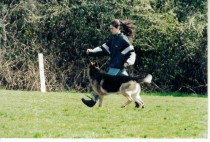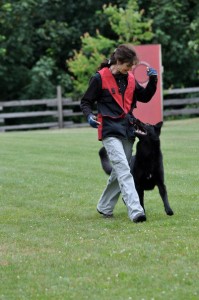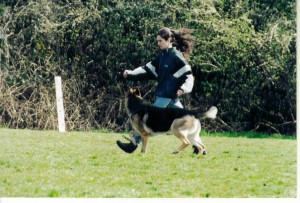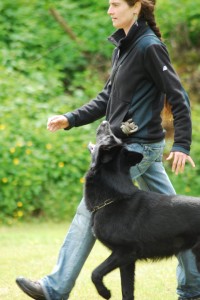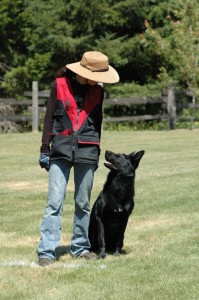I am honored to publish a guest post by Shade Whitesel (Shade’s Dog Training), a nationally recognized Schutzhund trainer. She has been working in Schutzhund/IPO for 15 years. Shade has achieved 100 points (a perfect score) in Schutzhund Tracking with two dogs. Her current competition dog is Reiki vom Aegis, who in his off time trains for French Ringsport and obtained Ring 1 title.
Shade and Reiki’s successes:
- 5th place 2010 AWDF
- 1st place 2011 NW Regionals USA
- 7th place 2012 AWDF
- 2nd place 2012 WDSA Nationals
Here is her story:
“Obedience within protection sports, control within Schutzhund bitework: however you look at it, the dog is at the highest state of arousal and excitement, wanting to bite the “bad guy helper/decoy”. Heeling at the speed of death at your side is the furthest thing from his mind. Traditionally we got obedience in protection sports by correction, to be technical about it, positive punishment. We said an obedience command, applied pressure till the dog complied, then the pressure went away. I think what we really did is ended up suppressing the dog’s drive/excitement just enough for him to be able to listen to you. If the dog didn’t listen, he received more suppressing positive punishment until he could hold it together and listen. With enough repetition the dogs figured it out. Whether it held up in trial was another thing all together.
The trouble for me was that I weighed 110 pounds and my dog weighed 95 pounds. E collars weren’t really used at that time, instead we mainly used choke and prong collars. And that meant strength to give an effective correction. As hard as I tried, I absolutely could not correct Jesse hard enough for him to hear me shouting “Fuss, fuss” during the transport exercise. (where the dog is supposed to heel by your side with the helper/bad guy walking 5 paces ahead.) And the one time a fellow trainer tried to show me how hard to correct him, Jess told that trainer (with his teeth) never to attempt to correct him again. As I would jerk away on the prong collar, Jess would just look at me, eyes bulging, forging away, his whole being focused toward his ultimate reward, the helper.
Wait a minute. His ultimate reward? The helper?
I already had taught him to heel with a ball in my hand. And then with a bumper in his send-out spot. Jesse already had an established history of working through me for a reward AWAY from me. Wasn’t the helper the same thing? In fact, even better, a reward I could direct around and not have to reset in the same spot each time.
A month later, Jess had a stellar back transport. Off leash. That held up in trial through his remaining 4 protection routines. And the method has held up through my next Schuzhund dogs, including competing numerous times at the National level.Start the training at lower arousal. Suggestions: ball on the ground, friend with a tug, helper with a bite tug not moving, helper with a bite tug moving, helper with a sleeve. Break it down to however many steps it takes to lay a correct foundation. With the leash, prevent the dog from reaching his goal, whether ball, bite tug or helper, but make sure to give enough slack to reward choices. In other words, do not drag the dog into heel position and hold him there! To start the process, say a simple obedience cue and wait for the dog to stop barking/lunging/staring in frustration at not being able to reach his reward. Be quiet and let the dog figure it out. Repeat cue for obedience. Wait some more as the dog works it out that he is not getting the reward. When he finally does the simple cue you have asked, mark, send to bite and allow him to get his reward! As the dog can handle one step, advance up to the next arousal level. Make sure to generalize the concept on many fields and on different helpers/people, lowering criteria (making the cue simpler) if necessary.
One day it finally clicks for both of you. The dog figures out the concept of working through you, not against you, to get what he wants. And you figure out how to set up the dog’s environment to promote correct choices instead of setting him up for failure.
Truthfully, it took me 2 Schutzhund dogs and their back transport exercises to fully convert me to looking for positive ways in protection work. That led to looking for positive ways to train behaviors in the other phases in Schutzhund, obedience and tracking. And then the positive way morphed into teaching house manners for my own dogs, and into my business training other people to teach their dogs. I am constantly searching for ways to make me and my clients into better, more effective and more positive teachers for our wonderful companions, our dogs.Most of all, I thank Jesse for the teachings he gave me, and apologize to him for the training I subjected him to.”
In this video, at the 2 minute point, Shade and Reiki do a “transport” with the helper.
References: Events-PosiDog Canine Learning Center
